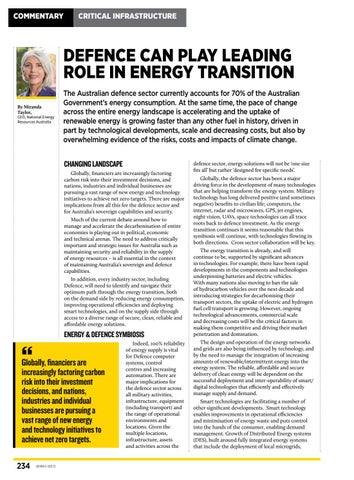COMMENTARY
CRITICAL INFRASTRUCTURE
DEFENCE CAN PLAY LEADING ROLE IN ENERGY TRANSITION By Miranda Taylor,
CEO, National Energy Resources Australia
The Australian defence sector currently accounts for 70% of the Australian Government’s energy consumption. At the same time, the pace of change across the entire energy landscape is accelerating and the uptake of renewable energy is growing faster than any other fuel in history, driven in part by technological developments, scale and decreasing costs, but also by overwhelming evidence of the risks, costs and impacts of climate change.
CHANGING LANDSCAPE Globally, financiers are increasingly factoring carbon risk into their investment decisions, and nations, industries and individual businesses are pursuing a vast range of new energy and technology initiatives to achieve net zero targets. There are major implications from all this for the defence sector and for Australia’s sovereign capabilities and security. Much of the current debate around how to manage and accelerate the decarbonisation of entire economies is playing out in political, economic and technical arenas. The need to address critically important and strategic issues for Australia such as maintaining security and reliability in the supply of energy resources – is all essential in the context of maintaining Australia’s sovereign and defence capabilities. In addition, every industry sector, including Defence, will need to identify and navigate their optimum path through the energy transition, both on the demand side by reducing energy consumption, improving operational efficiencies and deploying smart technologies, and on the supply side through access to a diverse range of secure, clean, reliable and affordable energy solutions.
ENERGY & DEFENCE SYMBIOSIS
“
Globally, financiers are increasingly factoring carbon risk into their investment decisions, and nations, industries and individual businesses are pursuing a vast range of new energy and technology initiatives to achieve net zero targets.
234
EDITION 4 • 2021-22
Indeed, 100% reliability of energy supply is vital for Defence computer systems, control centres and increasing automation. There are major implications for the defence sector across all military activities, infrastructure, equipment (including transport) and the range of operational environments and locations. Given the multiple locations, infrastructure, assets and activities across the
defence sector, energy solutions will not be ‘one size fits all’ but rather ‘designed for specific needs’. Globally, the defence sector has been a major driving force in the development of many technologies that are helping transform the energy system. Military technology has long delivered positive (and sometimes negative) benefits to civilian life; computers, the internet, radar and microwaves, GPS, jet engines, night vision, UAVs, space technologies can all trace roots back to defence investment. As the energy transition continues it seems reasonable that this symbiosis will continue, with technologies flowing in both directions. Cross sector collaboration will be key. The energy transition is already, and will continue to be, supported by significant advances in technologies. For example, there have been rapid developments in the components and technologies underpinning batteries and electric vehicles. With many nations also moving to ban the sale of hydrocarbon vehicles over the next decade and introducing strategies for decarbonising their transport sectors, the uptake of electric and hydrogen fuel cell transport is growing. However, ongoing technological advancements, commercial scale and decreasing costs will be the critical factors in making them competitive and driving their market penetration and domination. The design and operation of the energy networks and grids are also being influenced by technology, and by the need to manage the integration of increasing amounts of renewable/intermittent energy into the energy system. The reliable, affordable and secure delivery of clean energy will be dependent on the successful deployment and inter-operability of smart/ digital technologies that efficiently and effectively manage supply and demand. Smart technologies are facilitating a number of other significant developments. Smart technology enables improvements in operational efficiencies and minimisation of energy waste and puts control into the hands of the consumer, enabling demand management. Growth of Distributed Energy systems (DES), built around fully integrated energy systems that include the deployment of local microgrids,
